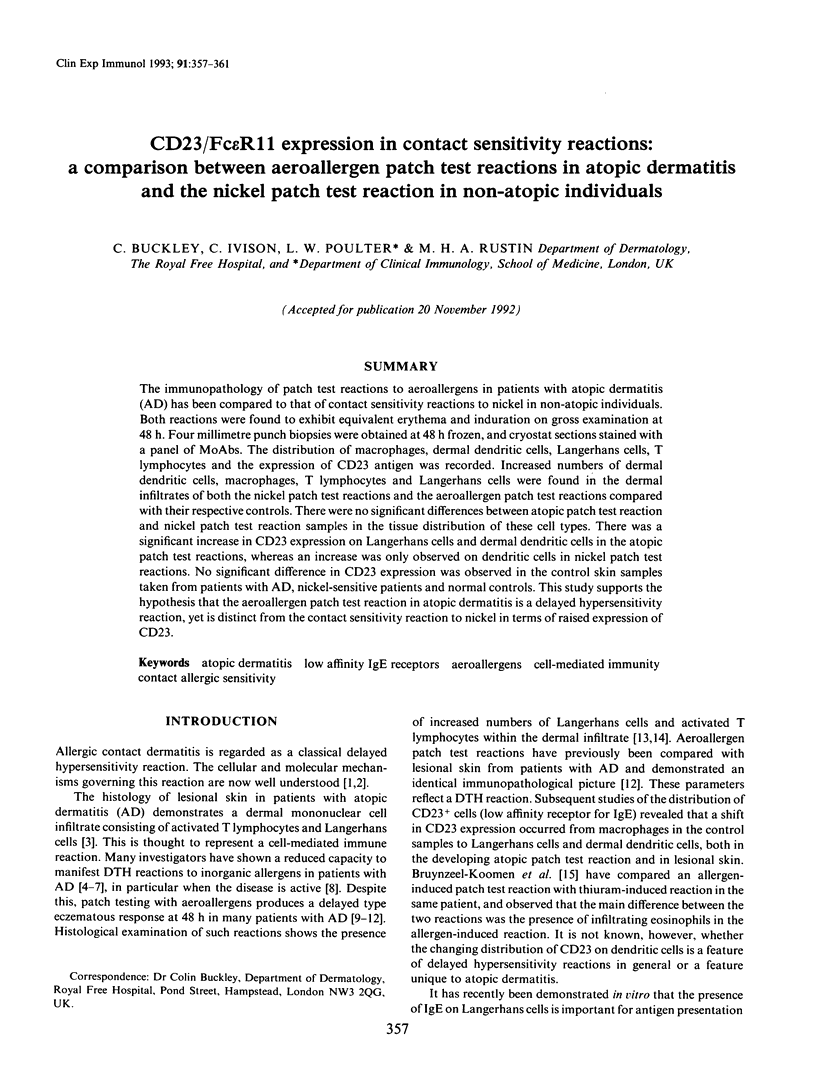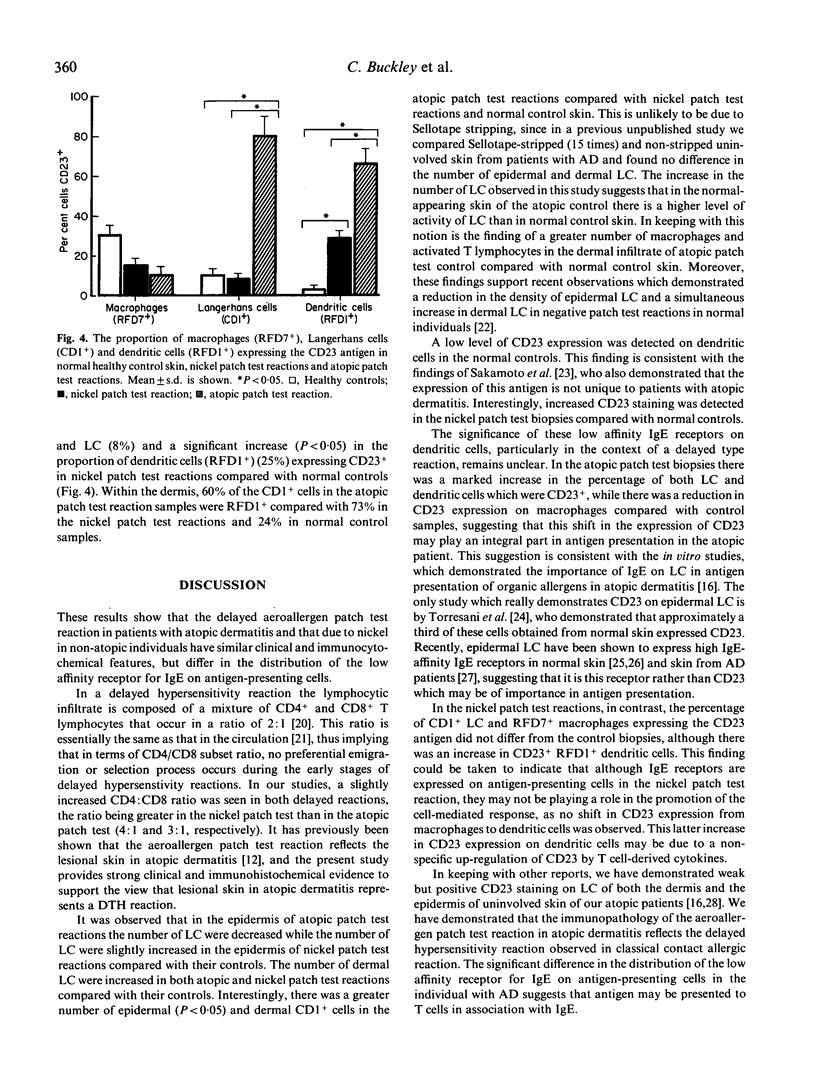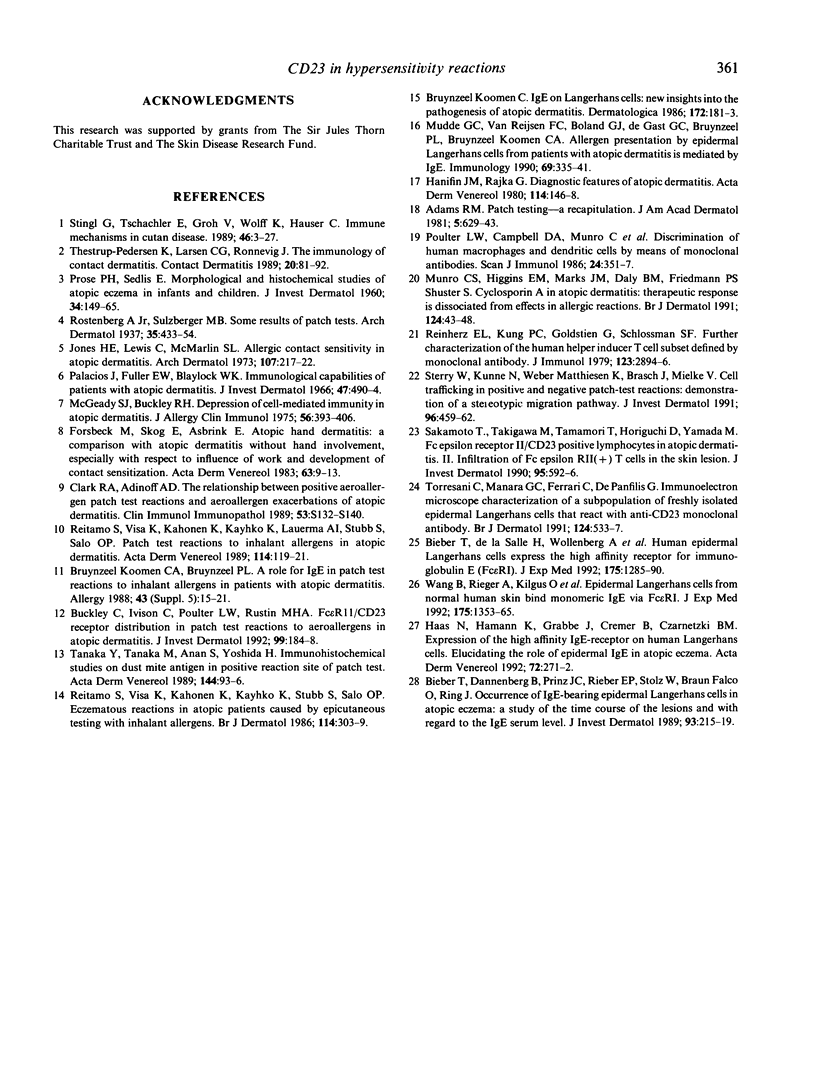Abstract
The immunopathology of patch test reactions to aeroallergens in patients with atopic dermatitis (AD) has been compared to that of contact sensitivity reactions to nickel in non-atopic individuals. Both reactions were found to exhibit equivalent erythema and induration on gross examination at 48 h. Four millimetre punch biopsies were obtained at 48 h frozen, and cryostat sections stained with a panel of MoAbs. The distribution of macrophages, dermal dendritic cells, Langerhans cells, T lymphocytes and the expression of CD23 antigen was recorded. Increased numbers of dermal dendritic cells, macrophages, T lymphocytes and Langerhans cells were found in the dermal infiltrates of both the nickel patch test reactions and the aeroallergen patch test reactions compared with their respective controls. There were no significant differences between atopic patch test reaction and nickel patch test reaction samples in the tissue distribution of these cell types. There was a significant increase in CD23 expression on Langerhans cells and dermal dendritic cells in the atopic patch test reactions, whereas an increase was only observed on dendritic cells in nickel patch test reactions. No significant difference in CD23 expression was observed in the control skin samples taken from patients with AD, nickel-sensitive patients and normal controls. This study supports the hypothesis that the aeroallergen patch test reaction in atopic dermatitis is a delayed hypersensitivity reaction, yet is distinct from the contact sensitivity reaction to nickel in terms of raised expression of CD23.
Full text
PDF




Selected References
These references are in PubMed. This may not be the complete list of references from this article.
- Adams R. M. Patch testing--a recapitulation. J Am Acad Dermatol. 1981 Dec;5(6):629–646. doi: 10.1016/s0190-9622(81)70124-5. [DOI] [PubMed] [Google Scholar]
- Bieber T., Dannenberg B., Prinz J. C., Rieber E. P., Stolz W., Braun-Falco O., Ring J. Occurrence of IgE-bearing epidermal Langerhans cells in atopic eczema: a study of the time course of the lesions and with regard to the IgE serum level. J Invest Dermatol. 1989 Aug;93(2):215–219. doi: 10.1111/1523-1747.ep12277574. [DOI] [PubMed] [Google Scholar]
- Bieber T., de la Salle H., Wollenberg A., Hakimi J., Chizzonite R., Ring J., Hanau D., de la Salle C. Human epidermal Langerhans cells express the high affinity receptor for immunoglobulin E (Fc epsilon RI). J Exp Med. 1992 May 1;175(5):1285–1290. doi: 10.1084/jem.175.5.1285. [DOI] [PMC free article] [PubMed] [Google Scholar]
- Bruynzeel-Koomen C. A., Bruynzeel P. L. A role for IgE in patch test reactions to inhalant allergens in patients with atopic dermatitis. Allergy. 1988;43 (Suppl 5):15–21. doi: 10.1111/j.1398-9995.1988.tb05043.x. [DOI] [PubMed] [Google Scholar]
- Bruynzeel-Koomen C. IgE on Langerhans cells: new insights into the pathogenesis of atopic dermatitis. Dermatologica. 1986;172(4):181–183. doi: 10.1159/000249331. [DOI] [PubMed] [Google Scholar]
- Buckley C. C., Ivison C., Poulter L. W., Rustin M. H. Fc epsilon R11/CD23 receptor distribution in patch test reactions to aeroallergens in atopic dermatitis. J Invest Dermatol. 1992 Aug;99(2):184–188. doi: 10.1111/1523-1747.ep12616813. [DOI] [PubMed] [Google Scholar]
- Clark R. A., Adinoff A. D. The relationship between positive aeroallergen patch test reactions and aeroallergen exacerbations of atopic dermatitis. Clin Immunol Immunopathol. 1989 Nov;53(2 Pt 2):S132–S140. doi: 10.1016/0090-1229(89)90078-0. [DOI] [PubMed] [Google Scholar]
- Forsbeck M., Skog E., Asbrink E. Atopic hand dermatitis: a comparison with atopic dermatitis without hand involvement, especially with respect to influence of work and development of contact sensitization. Acta Derm Venereol. 1983;63(1):9–13. [PubMed] [Google Scholar]
- Haas N., Hamann K., Grabbe J., Cremer B., Czarnetzki B. M. Expression of the high affinity IgE-receptor on human Langerhans' cells. Elucidating the role of epidermal IgE in atopic eczema. Acta Derm Venereol. 1992 Aug;72(4):271–272. [PubMed] [Google Scholar]
- Jones H. E., Lewis C. W., McMarlin S. L. Allergic contact sensitivity in atopic dermatitis. Arch Dermatol. 1973 Feb;107(2):217–222. [PubMed] [Google Scholar]
- McGeady S. J., Buckley R. H. Depression of cell-mediated immunity in atopic eczema. J Allergy Clin Immunol. 1975 Nov;56(5):393–406. doi: 10.1016/0091-6749(75)90133-5. [DOI] [PubMed] [Google Scholar]
- Mudde G. C., Van Reijsen F. C., Boland G. J., de Gast G. C., Bruijnzeel P. L., Bruijnzeel-Koomen C. A. Allergen presentation by epidermal Langerhans' cells from patients with atopic dermatitis is mediated by IgE. Immunology. 1990 Mar;69(3):335–341. [PMC free article] [PubMed] [Google Scholar]
- Munro C. S., Higgins E. M., Marks J. M., Daly B. M., Friedmann P. S., Shuster S. Cyclosporin A in atopic dermatitis: therapeutic response is dissociated from effects on allergic reactions. Br J Dermatol. 1991 Jan;124(1):43–48. doi: 10.1111/j.1365-2133.1991.tb03280.x. [DOI] [PubMed] [Google Scholar]
- PROSE P. H., SEDLIS E. Morphologic and histochemical studies of atopic eczema in infants and children. J Invest Dermatol. 1960 Feb;34:149–165. [PubMed] [Google Scholar]
- Palacios J., Fuller E. W., Blaylock W. K. Immunological capabilities of patients with atopic dermatitis. J Invest Dermatol. 1966 Nov;47(5):484–490. doi: 10.1038/jid.1966.172. [DOI] [PubMed] [Google Scholar]
- Poulter L. W., Campbell D. A., Munro C., Janossy G. Discrimination of human macrophages and dendritic cells by means of monoclonal antibodies. Scand J Immunol. 1986 Sep;24(3):351–357. doi: 10.1111/j.1365-3083.1986.tb02104.x. [DOI] [PubMed] [Google Scholar]
- Reinherz E. L., Kung P. C., Goldstein G., Schlossman S. F. Further characterization of the human inducer T cell subset defined by monoclonal antibody. J Immunol. 1979 Dec;123(6):2894–2896. [PubMed] [Google Scholar]
- Reitamo S., Visa K., Kähönen K., Käyhkö K., Lauerma A. I., Stubb S., Salo O. P. Patch test reactions to inhalant allergens in atopic dermatitis. Acta Derm Venereol Suppl (Stockh) 1989;144:119–121. [PubMed] [Google Scholar]
- Reitamo S., Visa K., Kähönen K., Käyhkö K., Stubb S., Salo O. P. Eczematous reactions in atopic patients caused by epicutaneous testing with inhalant allergens. Br J Dermatol. 1986 Mar;114(3):303–309. doi: 10.1111/j.1365-2133.1986.tb02821.x. [DOI] [PubMed] [Google Scholar]
- Sakamoto T., Takigawa M., Tamamori T., Horiguchi D., Yamada M. Fc epsilon receptor II/CD23 positive lymphocytes in atopic dermatitis: II. Infiltration of Fc epsilon R II(+) T cells in the skin lesion. J Invest Dermatol. 1990 Nov;95(5):592–596. doi: 10.1111/1523-1747.ep12505589. [DOI] [PubMed] [Google Scholar]
- Sterry W., Künne N., Weber-Matthiesen K., Brasch J., Mielke V. Cell trafficking in positive and negative patch-test reactions: demonstration of a stereotypic migration pathway. J Invest Dermatol. 1991 Apr;96(4):459–462. doi: 10.1111/1523-1747.ep12470141. [DOI] [PubMed] [Google Scholar]
- Tanaka Y., Tanaka M., Anan S., Yoshida H. Immunohistochemical studies on dust mite antigen in positive reaction site of patch test. Acta Derm Venereol Suppl (Stockh) 1989;144:93–96. doi: 10.2340/000155551449396. [DOI] [PubMed] [Google Scholar]
- Thestrup-Pedersen K., Larsen C. G., Rønnevig J. The immunology of contact dermatitis. A review with special reference to the pathophysiology of eczema. Contact Dermatitis. 1989 Feb;20(2):81–92. doi: 10.1111/j.1600-0536.1989.tb03113.x. [DOI] [PubMed] [Google Scholar]
- Torresani C., Manara G. C., Ferrari C., De Panfilis G. Immunoelectron microscopic characterization of a subpopulation of freshly isolated epidermal Langerhans cells that reacts with anti-CD23 monoclonal antibody. Br J Dermatol. 1991 Jun;124(6):533–537. doi: 10.1111/j.1365-2133.1991.tb04945.x. [DOI] [PubMed] [Google Scholar]
- Wang B., Rieger A., Kilgus O., Ochiai K., Maurer D., Födinger D., Kinet J. P., Stingl G. Epidermal Langerhans cells from normal human skin bind monomeric IgE via Fc epsilon RI. J Exp Med. 1992 May 1;175(5):1353–1365. doi: 10.1084/jem.175.5.1353. [DOI] [PMC free article] [PubMed] [Google Scholar]


